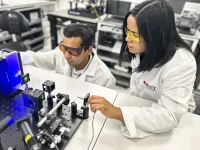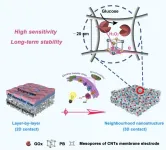(Press-News.org) INDIANAPOLIS — In one of the first studies to investigate racial disparities in the pharmacologic treatment of insomnia, researchers from Regenstrief Institute and Indiana University report that patients belonging to racial minority groups were significantly less likely to be prescribed medication following diagnosis of insomnia than White patients.
The study found that Black patients were much less likely to have been prescribed an FDA-approved insomnia medication at any time post diagnosis than White patients. Other non-White individuals were significantly less likely to be prescribed an FDA-approved medication two, three, and four years after insomnia diagnosis but not in year one.
“We looked at comorbidities -- anxiety disorders and depression -- and we looked at where individuals lived and other factors that might account for the disparity in prescriptions for medications following a diagnosis of insomnia,” noted co-author and Regenstrief Research Scientist Malaz Boustani, M.D., MPH. “We found that race was the only variable that accounted for the differences in treatment.”
The researchers reported that despite older patients and those with comorbidities being less likely to be prescribed insomnia medications regardless of race, White patients overall still had a shorter period between diagnosis and prescription than other races.
Insomnia is a common sleep disorder involving difficulty falling asleep, staying asleep or getting good-quality sleep. According to the U.S. Centers for Disease Control and Prevention, not getting enough sleep is linked with many chronic diseases and conditions including type 2 diabetes, heart disease, obesity and depression.
“We did this study to simply identify treatment trends,” said Regenstrief Institute Research Scientist Noll Campbell, PharmD, M.S., a study co-author. “Are the trends we found caused by individual patient preferences, group-based preferences, or are they the result of different approaches to nonpharmacologic options for the treatment of insomnia? Future research will be needed to discern why these trends are occurring.”
In this study, Indiana Network for Patient Care (INPC) data from about 10,000 individuals who were prescribed FDA-approved medications for insomnia was analyzed. The INPC is managed by the Indiana Health Information Exchange. Regenstrief created the INPC and provides access to data for research purposes.
“The Indiana Network for Patient Care proved once again to be an invaluable resource for understanding clinical practice. It was only through the INPC that we obtained the demographic, diagnostic, medication, and clinical notes data necessary for analyzing racial disparities in insomnia medication prescribing,” said Regenstrief Institute Research Scientist Paul Dexter, M.D., a study co-author and clinician-informatician.
“The systematic analysis of electronic health records data can play an important role in helping us uncover disparities that can be acted upon towards more equitable care, said Regenstrief Institute Research Scientist Arthur Owora, PhD, MPH, the study senior author. “This potential is highlighted by this study; however, given the inherent deficits of secondary data sources, a cautious interpretation is warranted, and further research is needed to better understand how and to what extent patient preferences and patient-clinician interactions may have contributed to the observed disparities in insomnia treatment.”
The study population was 75 percent White, 69 percent female and 62 percent non-Hispanic. Average age at the time of insomnia diagnosis was 61.
“In addition to revealing racial disparity in prescription of medications for insomnia, the data suggests that providers may be undertreating insomnia,” said study first author Emma Holler, MPH, a doctoral student and clinical epidemiologist with Indiana University School of Public Health -- Bloomington.
“Racial disparities in the pharmacological treatment of insomnia: A time-to-event analysis using real-world data” is published in the peer-reviewed journal Sleep Medicine.
This work was supported in part by Merck Sharp & Dohme Corp., a subsidiary of Merck & Co., Inc.
Authors
Emma Holler 1, Noll L. Campbell 2, Malaz Boustani 3, Paul Dexter 4, Zina Ben Miled 5, Arthur Owora 6.
Affiliations
1 Department of Epidemiology and Biostatistics, Indiana University Bloomington, Bloomington, Indiana, USA. Electronic address: emorone@iu.edu.
2 College of Pharmacy, Purdue University, West Lafayette, Indiana, USA; Indiana University Center for Aging Research, Regenstrief Institute, Indianapolis, Indiana, USA; Center for Healthcare Innovation and Implementation Science, Indiana University, Indianapolis, Indiana, USA.
3 Indiana University Center for Aging Research, Regenstrief Institute, Indianapolis, Indiana, USA; Center for Healthcare Innovation and Implementation Science, Indiana University, Indianapolis, Indiana, USA; Department of Internal Medicine, Indiana University School of Medicine, Indianapolis, Indiana, USA.
4 Department of Internal Medicine, Indiana University School of Medicine, Indianapolis, Indiana, USA; Clem McDonald Center for Biomedical Informatics, Regenstrief Institute, Indianapolis, Indiana, USA.
5 Department of Electrical and Computer Engineering, Indiana University Purdue University at Indianapolis, Indianapolis, Indiana, USA.
6 Department of Epidemiology and Biostatistics, Indiana University Bloomington, Bloomington, Indiana, USA.
About Malaz Boustani, M.D., MPH
In addition to his role as a research scientist at Regenstrief Institute, Malaz Boustani, M.D., MPH, is the founding director of the Center for Health Innovation and Implementation Science. He is a professor and the Richard M. Fairbanks Professor in Aging Research at Indiana University School of Medicine. Dr. Boustani is also director of care innovation at Eskenazi Health.
About Noll Campbell, PharmD, M.S.
In addition to his role as a research scientist at Regenstrief Institute, Noll Campbell, PharmD, M.S., is an associate professor of pharmacy practice at the Purdue University College of Pharmacy. He is an adjunct associate professor of medicine at Indiana University School of Medicine and maintains an active clinical practice as a geriatric pharmacotherapy expert within Eskenazi Health.
About Paul R. Dexter, M.D.
In addition to his role as a research scientist at Regenstrief Institute, Paul R. Dexter, M.D., is an associate professor of clinical medicine at Indiana University School of Medicine.
About Arthur H. Owora, MPH, PhD
In addition to his role as a research scientist at Regenstrief Institute, Arthur H. Owora, PhD., is an associate professor of pediatrics at Indiana University School of Medicine. He is an adjunct associate professor of biostatistics and epidemiology at Indiana University School of Public Health-Bloomington.
About Regenstrief Institute
Founded in 1969 in Indianapolis, Regenstrief Institute is a local, national and global leader dedicated to a world where better information empowers people to end disease and realize true health. A key research partner to Indiana University, Regenstrief and its research scientists are responsible for a growing number of major healthcare innovations and studies. Examples range from the development of global health information technology standards that enable the use and interoperability of electronic health records to improving patient-physician communications, to creating models of care that inform practice and improve the lives of patients around the globe.
Sam Regenstrief, a nationally successful entrepreneur from Connersville, Indiana, founded the institute with the goal of making healthcare more efficient and accessible for everyone. His vision continues to guide the institute’s research mission.
About IU School of Medicine
IU School of Medicine is the largest medical school in the U.S. and is annually ranked among the top medical schools in the nation by U.S. News & World Report. The school offers high-quality medical education, access to leading medical research and rich campus life in nine Indiana cities, including rural and urban locations consistently recognized for livability.
About Purdue University College of Pharmacy
The mission of the Purdue University College of Pharmacy is to advance scientific discovery and development, maximize global health outcomes through patient care and public service, and educate and train students to become leading pharmacists and scientists. The goal is to transform the practice and science of pharmacy to lead advances in human health.
About IU School of Public Health-Bloomington
IU School of Public Health-Bloomington (SPH-B) is one of the largest schools of public health in the United States, offering top-ranked programs in a wide range of health-related fields. Accredited by the Council on Education for Public Health (CEPH), the school aims to promote health among individuals in Indiana, the nation, and the world through integrated multidisciplinary approaches to research and creative activities, teaching, and community engagement.
END
Racial disparities found in one of first studies of pharmacological treatment of insomnia
Underlying causes still unknown, including patient, family or group preferences
2023-06-14
ELSE PRESS RELEASES FROM THIS DATE:
New York Academy of Sciences, Leon Levy Foundation name first 10 Leon Levy Scholars in Neuroscience
2023-06-14
New York, NY, June 14, 2023 — The New York Academy of Sciences and the Leon Levy Foundation announced today the first cohort of Leon Levy Scholars in Neuroscience; a continuation of an earlier fellowship program started by the Foundation in 2009 that has supported 160 fellows in neuroscience.
This highly regarded postdoctoral program supports exceptional young researchers across the five boroughs of New York City as they pursue innovative investigations in neuroscience and advance in their careers toward becoming independent principal investigators. Designed to broaden the field and to support researchers who might otherwise not ...
Cancer researchers focused on bringing new discoveries to patients get two-year funding awards
2023-06-14
June 14, 2023, TORONTO — Funding announced today by the Ontario Institute for Cancer Research (OICR) will help six Ontario-based research teams pursue their ultimate goal of improving the lives of people with cancer.
Funding comes through OICR’s Innovation to Implementation (I2I) program, which aims to help ensure new discoveries about preventing, diagnosing and treating cancer are adopted into healthcare policy and clinical practice.
“Every cancer researcher wants their work to have ...
Dr. Jonathan Weinsaft named chief of the Greenberg Division of Cardiology at Weill Cornell Medicine and NewYork-Presbyterian/Weill Cornell Medical Center
2023-06-14
NEW YORK (June 14, 2023)— Dr. Jonathan Weinsaft, an esteemed physician-scientist who focuses on clinical research and cardiovascular imaging, has been appointed chief of the Greenberg Division of Cardiology at Weill Cornell Medicine and NewYork-Presbyterian/Weill Cornell Medical Center, effective July 1.
The Greenberg Division of Cardiology, housed within the Weill Department of Medicine, is dedicated to diagnosing and treating patients with disorders of the heart and blood vessels that comprise the cardiovascular system.
In his new role, Dr. Weinsaft will further strengthen the division as a leader in scientific and technological ...
New diagnostic finds intact sperm in infertile men
2023-06-14
In a recent study, researchers created a diagnostic test to identify functional sperm in infertile men that could change the treatment of male infertility and assisted reproductive technology.
“Male infertility is a recognized issue and deserves scientific and clinical attention,” said Andrei Drabovich, an assistant professor of laboratory medicine and pathology at the University of Alberta and corresponding author of the Molecular & Cellular Proteomics study.
One in every six couples trying to conceive experience infertility issues. In fact, about 10% of men in the United States are infertile. The most ...
A novel technique to observe colloidal particle degradation in real time
2023-06-14
In the early 2000s, scientists from the UK made a worrisome discovery that the oceans are teeming with small particles of plastic (less than one millimeter in length) due to the continuous degradation of plastic waste. These microscopic particles of plastic have become a major environmental concern. Scientists classify these small particles as either microplastics or nanoplastics based on their size; the latter term is used exclusively for particles smaller than one micrometer.
These particles easily get embedded into the bodies of marine and freshwater animals, ...
Tiny device mimics human vision and memory abilities
2023-06-14
Researchers have created a small device that ‘sees’ and creates memories in a similar way to humans, in a promising step towards one day having applications that can make rapid, complex decisions such as in self-driving cars.
The neuromorphic invention is a single chip enabled by a sensing element, doped indium oxide, that’s thousands of times thinner than a human hair and requires no external parts to operate.
RMIT University engineers in Australia led the work, with contributions from researchers at Deakin University and the University of Melbourne.
The team’s research demonstrates a working device that captures, processes and stores visual ...
Solar cells can, finally, stand the heat
2023-06-14
SDE BOKER, Israel, June 14, 2023 – Photovoltaic technology is indispensable for our ability to mitigate climate change. Nonetheless, more than 70% of the energy made available to us by the sun is wasted in conventional photovoltaic cells. There is little hope for sustainable technological advancement without addressing this issue.
The operational temperature is a critical factor in a solar cell's ability to convert sunlight to free energy. Accordingly, much research has been directed toward understanding the temperature effects in the efficiency of photovoltaic solar cells. Surprisingly, ...
Scientists develop novel biosensing-membrane for glucose detection and monitoring
2023-06-14
Glucose oxidase (GOx)-based biosensors have attracted much attention for their potential in rapid glucose detection and continuous monitoring, which are crucial for disease diagnosis and prevention, as well as for controllable production in sugar-making and fermentation processes.
The glucose oxidase/electrocatalysts/electrode (GOx/ECs/electrode) cascade system serves as the core part of most glucose biosensing devices (both invasive and non-invasive). However, patterned assembly of these cascade sensing units remains challenging, thus limiting the ...
Improving word intelligibility of bone-conducted speech using bone-conduction headphones
2023-06-14
Ishikawa, Japan -- Bone-conduction (BC) headphones enhance hearing capability by generating vibrations in bone or skin close to the ear, including the regio temporalis. They simultaneously leave the ear canal open to allow the surrounding air-conducted (AC) sounds for normal hearing. However, word intelligibility – recognition ability – is often poor during bone-conducted speech perceived using BC headphones due to the attenuation of its high-frequency components, especially under noisy conditions. While inserting ear plugs in the ear canal help improve ...
Study shines new light on old drug for trauma care
2023-06-14
A new study from Australia, New Zealand and Germany published in the New England Journal of Medicine raises important questions about the success or otherwise of emergency medicine.
The study examined the drug tranexamic acid, which is commonly used to limit bleeding during surgery. However, its usefulness in emergency settings as a pre-emptive strike in life-threatening bleeding has been controversial, and recent studies have provided contradictory results about whether or not it saves lives or causes dangerous blood clotting.
The Pre-hospital ...
LAST 30 PRESS RELEASES:
Researchers identify gene that calms the mind and improves attention in mice
Artificial metabolism turns waste CO2 into useful chemicals
Ancient sea anemone sheds light on animal cell type evolution
Begging gene leads to drone food
How climate policies that incentivize and penalize can drive the clean energy transition
Can community awareness campaigns in low-resource areas improve early diagnosis of colorectal cancer?
Stardust study resets how life’s atoms spread through space
Practical education: Clinical scenario-based program development
The impact of family dynamics on eating behaviour – how going home for Christmas can change how you eat
Tracing the quick synthesis of an industrially important catalyst
New software sheds light on cancer’s hidden genetic networks
UT Health San Antonio awarded $3 million in CPRIT grants to bolster cancer research and prevention efforts in South Texas
Third symposium spotlights global challenge of new contaminants in China’s fight against pollution
From straw to soil harmony: International team reveals how biochar supercharges carbon-smart farming
Myeloma: How AI is redrawing the map of cancer care
Manhattan E. Charurat, Ph.D., MHS invested as the Homer and Martha Gudelsky Distinguished Professor in Medicine at the University of Maryland School of Medicine
Insilico Medicine’s Pharma.AI Q4 Winter Launch Recap: Revolutionizing drug discovery with cutting-edge AI innovations, accelerating the path to pharmaceutical superintelligence
Nanoplastics have diet-dependent impacts on digestive system health
Brain neuron death occurs throughout life and increases with age, a natural human protein drug may halt neuron death in Alzheimer’s disease
SPIE and CLP announce the recipients of the 2025 Advanced Photonics Young Innovator Award
Lessons from the Caldor Fire’s Christmas Valley ‘Miracle’
Ant societies rose by trading individual protection for collective power
Research reveals how ancient viral DNA shapes early embryonic development
A molecular gatekeeper that controls protein synthesis
New ‘cloaking device’ concept to shield sensitive tech from magnetic fields
Researchers show impact of mountain building and climate change on alpine biodiversity
Study models the transition from Neanderthals to modern humans in Europe
University of Phoenix College of Doctoral Studies releases white paper on AI-driven skilling to reduce burnout and restore worker autonomy
AIs fail at the game of visual “telephone”
The levers for a sustainable food system
[Press-News.org] Racial disparities found in one of first studies of pharmacological treatment of insomniaUnderlying causes still unknown, including patient, family or group preferences





